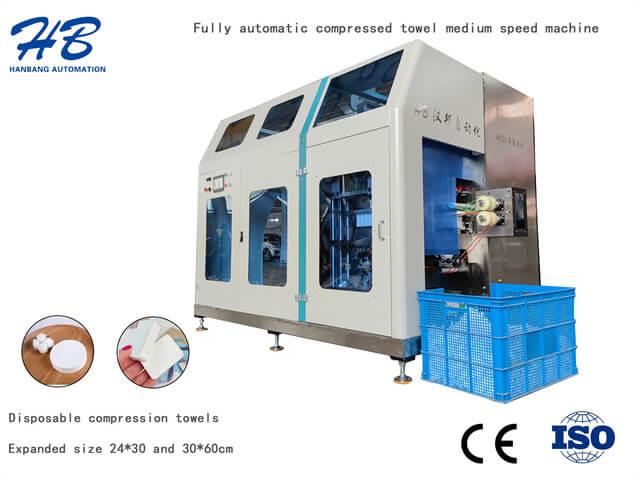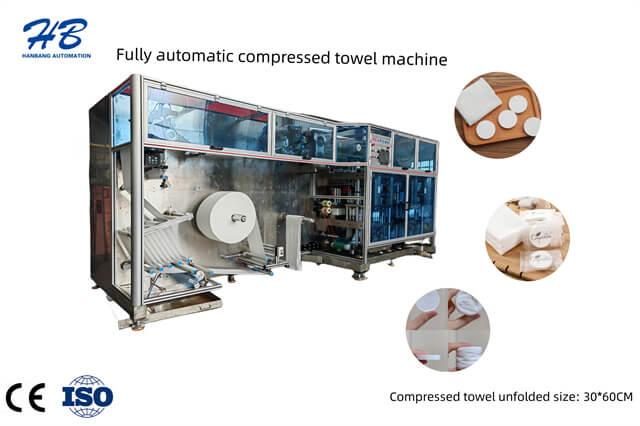Author:HB Nonwoven MachineryFROM:Compressed Towel Machine Manufacturer TIME:2024-01-02
With the increasing demand for hygiene products such as diapers and sanitary napkins, the nonwoven fabric machine plays a crucial role in the production of these essential items. This advanced machinery is designed to manufacture high-quality nonwoven fabrics, which are used as the main material for diapers and sanitary napkins. In this article, we will explore the technical features of a nonwoven fabric machine and how it contributes to the hygiene product industry.

One of the key features of a nonwoven fabric machine is its ability to operate at high speeds. This allows for efficient production, ensuring a continuous supply of nonwoven fabrics for the diaper and sanitary napkin manufacturing process. The machine is equipped with advanced automation systems that control the entire production process, including feeding, blending, and forming of the fibers. The high speed of the machin

The nonwoven fabric machine offers versatility in fiber blending, allowing manufacturers to produce fabrics with different properties. The machine can blend various types of fibers, such as cotton, polyester, and viscose, in different proportions, enabling the production of fabrics with desired absorbency, softness, and strength. This flexibility in fiber blending ensures that the nonwoven fabrics meet the specific requirements of diapers and sanitary napkins.
Achieving uniform web formation is crucial for the quality of nonwoven fabrics. The nonwoven fabric machine utilizes advanced web formation technology to ensure a precise and consistent web structure. This technology involves the accurate deposition and arrangement of fibers onto a moving conveyor belt, resulting in a well-bonded and stable fabric web. The precise web formation enhances the overall performance of diapers and sanitary napkins, including their absorption and leakage prevention capabilities.
Bonding is a critical process in nonwoven fabric production as it provides strength and stability to the fabric. The nonwoven fabric machine employs efficient bonding methods, such as thermal bonding and chemical bonding, to create strong and durable fabrics. Thermal bonding involves the application of heat to melt the fibers together, while chemical bonding utilizes adhesives to bond the fibers. These bonding methods ensure that the nonwoven fabrics have excellent integrity and can withstand the stresses associated with diaper and sanitary napkin usage.
The nonwoven fabric machine is equipped with advanced control systems that monitor and regulate various parameters during the production process. These control systems ensure the consistency and quality of the nonwoven fabrics by controlling factors such as temperature, pressure, and speed. The precise control of these parameters enables manufacturers to produce nonwoven fabrics with consistent properties, meeting the stringent standards set for hygiene products.
In an era where sustainability is paramount, energy efficiency is a key consideration for any manufacturing process. The nonwoven fabric machine incorporates energy-efficient technologies, such as variable frequency drives and optimized heating systems, to minimize energy consumption. By reducing energy waste, the machine contributes to a more sustainable and eco-friendly production of nonwoven fabrics for diapers and sanitary napkins.
The nonwoven fabric machine is designed for easy maintenance and troubleshooting, ensuring minimal downtime during production. The machine is equipped with user-friendly interfaces and diagnostic tools that enable operators to identify and resolve issues quickly. Regular maintenance and timely troubleshooting help prolong the lifespan of the machine, ensuring its reliable and continuous operation in the hygiene product industry.
The nonwoven fabric machine offers scalability and customization options to meet the evolving needs of the hygiene product industry. Manufacturers can choose machines with different capacities and configurations to scale their production according to market demand. Additionally, th

The nonwoven fabric machine is a technologically advanced equipment that plays a crucial role in the production of diapers and sanitary napkins. Its high speed production, versatility in fiber blending, precise web formation, efficient bonding methods, advanced control systems, energy efficiency, easy maintenance and troubleshooting, as well as scalability and customization options, contribute to the quality and efficiency of nonwoven fabric production. By continuously improving and innovating these technical features, the nonwoven fabric machine supports the growth of the hygiene product industry and meets the ever-increasing demand for these essential products.





